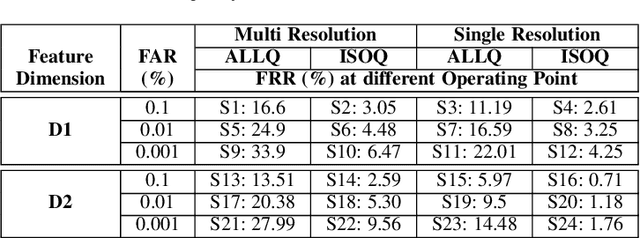Joseph Skufca
Uniqueness of Iris Pattern Based on AR Model
Jun 21, 2023Abstract:The assessment of iris uniqueness plays a crucial role in analyzing the capabilities and limitations of iris recognition systems. Among the various methodologies proposed, Daugman's approach to iris uniqueness stands out as one of the most widely accepted. According to Daugman, uniqueness refers to the iris recognition system's ability to enroll an increasing number of classes while maintaining a near-zero probability of collision between new and enrolled classes. Daugman's approach involves creating distinct IrisCode templates for each iris class within the system and evaluating the sustainable population under a fixed Hamming distance between codewords. In our previous work [23], we utilized Rate-Distortion Theory (as it pertains to the limits of error-correction codes) to establish boundaries for the maximum possible population of iris classes supported by Daugman's IrisCode, given the constraint of a fixed Hamming distance between codewords. Building upon that research, we propose a novel methodology to evaluate the scalability of an iris recognition system, while also measuring iris quality. We achieve this by employing a sphere-packing bound for Gaussian codewords and adopting a approach similar to Daugman's, which utilizes relative entropy as a distance measure between iris classes. To demonstrate the efficacy of our methodology, we illustrate its application on two small datasets of iris images. We determine the sustainable maximum population for each dataset based on the quality of the images. By providing these illustrations, we aim to assist researchers in comprehending the limitations inherent in their recognition systems, depending on the quality of their iris databases.
Empirical Assessment of End-to-End Iris Recognition System Capacity
Mar 20, 2023



Abstract:Iris is an established modality in biometric recognition applications including consumer electronics, e-commerce, border security, forensics, and de-duplication of identity at a national scale. In light of the expanding usage of biometric recognition, identity clash (when templates from two different people match) is an imperative factor of consideration for a system's deployment. This study explores system capacity estimation by empirically estimating the constrained capacity of an end-to-end iris recognition system (NIR systems with Daugman-based feature extraction) operating at an acceptable error rate i.e. the number of subjects a system can resolve before encountering an error. We study the impact of six system parameters on an iris recognition system's constrained capacity -- number of enrolled identities, image quality, template dimension, random feature elimination, filter resolution, and system operating point. In our assessment, we analyzed 13.2 million comparisons from 5158 unique identities for each of 24 different system configurations. This work provides a framework to better understand iris recognition system capacity as a function of biometric system configurations beyond the operating point, for large-scale applications.
 Add to Chrome
Add to Chrome Add to Firefox
Add to Firefox Add to Edge
Add to Edge